Murray Phillips: A Conversation with My Canvas
Murray Phillips (1944–2018)
Murray Phillips’ love and respect for Mother Nature was portrayed strongly in his artwork. As a signature member with Artists for Conservation [an artist run group dedicated to supporting nature through the arts] his passion for nature extended beyond just painting outdoors. From British Columbia’s Bugaboo Provincial Park to the Rocky Mountains in Alberta, Murray traveled far and wide to capture the beauty that the wilderness has to offer.
Murray shared his techniques for creating in the great outdoors and revealed how tuning into the rhythm of the wild can dramatically affect your artwork. Find out how Murray shared his stories from nature in the video above, or read the full exclusive article below.
For more outdoor inspiration, watch some of our other videos with artists out on the field.
Painting En Plein Air with Maria Josenhans
Opus Outdoor Painting Challenge 2012
Travel Easels at Opus
Working with Watermedia Outdoors
Painting with Golden OPEN Acrylics
Drawing from Inspiration
Interested in some of the products Murray uses?
Winsor & Newton Bristol Sketching Easel
Golden OPEN Acrylics
Golden Heavy Body Acrylics
Winsor & Newton Artists’ Acrylics
Liquitex Heavy Body Artist Acrylics
Golden’s Transparent Red Iron Oxide
Sta-Wet Palette
Cotton Brush Holder
Golden Gesso
Gamblin GamVar
Creative Environment
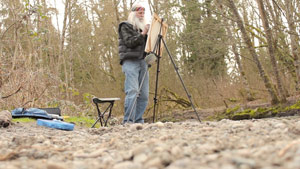
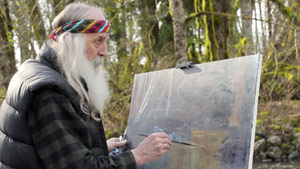
Opus: How would you describe your approach to painting outdoors?
Murray Phillips: What I want to do is paint in the wilderness and people often refer to that as plein air painting. But I am not sure I am a plein air painter. Usually, when people talk about plein air painting, they mean people who go to a particular situation, they are there for an hour or two, they do a small painting, and often they go back to their studio and do a large painting of that same scene. The process I use is very different.
I will go to a specific area for maybe 3 weeks at a time. I will spend the first day or two just exploring the area. Then I’ll pick out 5 or 6 places that I want to paint and I’ll go to all 6 places in one day. At the same hour every day, I go back to those specific locations and I repeat this cycle. That way I am not chasing the light for each one. I tend to stay shorter times in the morning, longer times around midday, and then shorter times again in the evening. I paint all day, and there are days where I paint 12-14 hours straight.
O: How do you decide your subject matter?
MP: Part of that is how you view what you are doing as a painter. I see myself as a painter who is a storyteller; I get to have a conversation with my canvas and I tell the story through it, but I only ever get to tell half the story. When somebody comes along and says, “That reminds me of the time…” they then pick it up and get to write the conclusion. So when I go through nature I’m consciously thinking, what story do I want to tell here? Because more than anything painting is a language; it’s an attempt to say something that we cannot say any other way. I want to see people pick up that story and go with it.
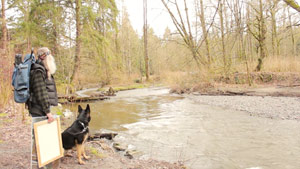
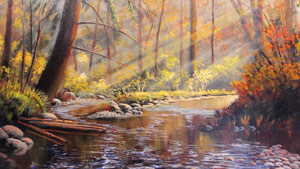
O: When you return the next day to your chosen locations, do you get a different feeling from your subject matter? How does that affect the progress of the painting?
MP: Nature has a certain rhythm to it. It is a very subtle rhythm that takes time to get into and to sense. Even if it’s the same time of day, it’s interesting how light can change; it can be bright one day and the next could be that same bright day but the light seems to have a different quality to it. You’ll notice things are moving and are in transition, which is the rhythm of nature. When that begins to happen it really seems to make a difference in the quality of the painting.
People today tend not to go into the wilderness but they go onto it. I find that a very important distinction because people often rush out to paint a quick picture and then run back out thinking they have painted nature but, in fact, they have taken their urban environment there. It takes time to make the transition from an urban setting to nature and to truly experience it.
O: Do you work in nature or do you work with it?
MP: I think I work with nature to a certain extent. At least, I try to, particularly in composition. I am the one who moves around to create the composition. I don’t move things around to get it because I want to be as authentic as I can. Now there are times when I admit that doesn’t work, something is just wrong but often it is artificial things, like a vehicle in the wrong place, and then you just don’t include it. Most of the time it’s a matter of getting the right light, which is something many people do not think about. When would the light be right for this mood? When would be the best time to get this light showing just the right way?
O: What mediums do you work in?
MP: I work with both acrylics and oils. I like acrylics because they dry fast and sometimes I am in situations where I want to paint quite quickly. What I like about oils is the process of painting with them. I just find them more enjoyable to work with. Acrylic is a little like painting on sandpaper where oils have this smoothness to them that I really enjoy. Although, now with Golden OPEN Acrylics there are some advantages of oils available. With a longer drying time they allow you to cover a large space before it dries and that is really helpful when working in acrylics outside.
Acrylics tend to dry a different colour than when they are applied, so I also like the Winsor & Newton Artists’ Acrylics because you don’t get a colour shift with them. I mix and match different brands a lot. If it’s a really dry, hot day, your acrylics can dry out awfully fast – I’m talking seconds. For example, I’ll use a Titanium White in an Open and mix it with another specific colour from W&N to help prolong its drying time.
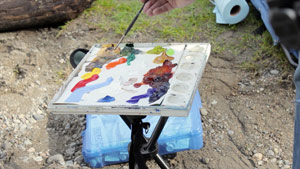

O: What techniques and materials do you find helpful when creating in nature?
MP: First of all I try to get my composition clear and part of that is figuring out when I want to paint the painting. Would it be a really good painting with the light coming from the east in the early morning? Or would it be a good painting with a warm evening light of the West?
I then start my painting using only one colour. I usually use a Transparent Red Iron Oxide from Golden because that way I can build up layers and get things placed where I want them. The reason I do that is then I am only worried about locating the situation as I want it to be on the canvas. I am not worried about getting the right colour and all of those other things at the same time. I move quite quickly once I get it laid out the way I want but that first part is really critical. Even with my oils I tend to begin with acrylics. It’s important for those who are starting out to try painting with one colour first and to use a big brush. That’s not to make it faster but to discipline you to deal with the blocks of colour and the image that is there rather than moving into detail too quickly.
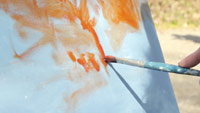


I really like Golden Gesso because I gesso my canvas frequently. I put 7 coats on because I want a highly reflective surface to help emphasis the light. The way I gesso my canvas is I use a black gesso first and then I put a white gesso overtop. This way I know that it is completely covered and I just repeat that until I get to the final layer. The last coat I mix black and white gesso so I have a grey finishing coat. I find white canvases hard to take in nature because you will have light reflecting off of it and it just skews the colours too much.
I tend to use watercolour brushes because I like the softness of them. I also really like Gamblin GamVar because sometimes for larger shows I will be varnishing 30 pieces and when I use other varnishes I have trouble breathing for a few days after. With GamVar I have not had that problem. I like the way it dries, its self-leveling, and it creates a reflective surface that is just so good.
I cannot recommend it enough.
O: How do you ensure a safe and proper cleanup when working outside?
MP: I am a signature member with Artists For Conservation [an artist group supporting the environment] and I take that very seriously. I try to make as little impact as I can on the environment. I try to carry out what I carry in. The water I use to clean my brushes, for example, I carry that out with me in a small bottle. You do have an impact by being there, which is unavoidable, but try to make your impact as little as possible.


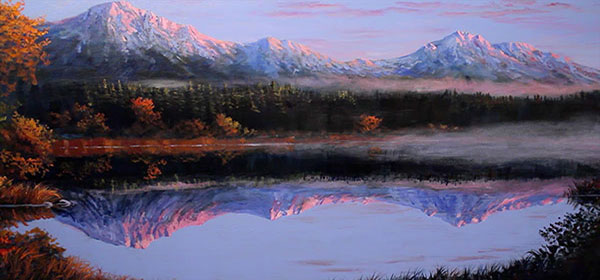
O: What do you experience and feel when you are painting in nature?
MP: We must understand that nature comes to us through all of our senses and not just one of them. I try to paint nature with the sense that I am completely there. I try to hear what’s going on around me; I smell what the smells are, I’m aware of the noises, the dangers. I try to be very conscious of everything that comes to my senses so I can incorporate them into my paintings. All those different stories are what I try to get onto a canvas. I notice a difference in my studio paintings and my paintings in nature. There is a qualitative difference with what happens and the ones created in nature feel more alive.
O: What are you trying to express about nature with your artwork?
MP: I think people become more interesting and more profound people by being in nature. One of the things I am trying to do is simply communicate that it’s there. I’m simply trying to awaken people to the fact that it is very important. Our culture is changing and its not just the matter of conservation, it’s the matter that this is a part of our world. To me, we become less human if we see the urban environment as our only environment. We need to see nature as a part of our environment and understand that we have a responsibility of stewardship for it.
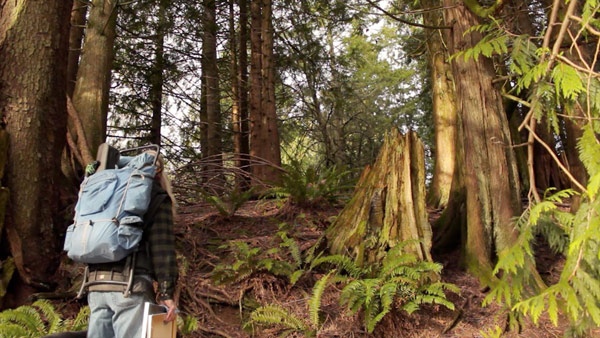
O: What would you say to someone who has never painted outdoors but is interested in trying it?
MP: First of all I would say just do it. Most people get hooked on painting faster when they are painting on location than any other thing I know. Do not try to paint the whole universe when you are out there. I recommend people carry L shaped cards so they can hold it up [framing their composition] and say, “This is what I am going to paint.”
You also need to buy certain things like a travel easel and transportable facilities so you can bring your tools with you. Studio painters often find it very awkward to try and transfer their studio out there, but you’re not trying to do that. All you’re trying to do out there is capture that image, and you have to do that as easily as possible. I think painting on location is the fastest way to learn to paint.
O: Why do you create?
MP: I create because I do not like my life when I don’t create. Something happens to me when I don’t create. I become less human than I should be. In a world that is highly run by routine, I find it very important to be creative. I think creating is part of what we are supposed to be and as I get older it’s becoming increasingly important. The sales of paintings are not as important as the process of painting. In the end I want to say to people, “I’ve named this. I’ve been here. I saw this. I was here when this looked like this.” •
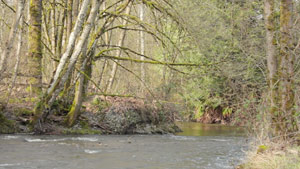

To learn more about Murray’s work, visit murrayphillipsart.com
Information about Artists For Conservation can be found at artistsforconservation.org
